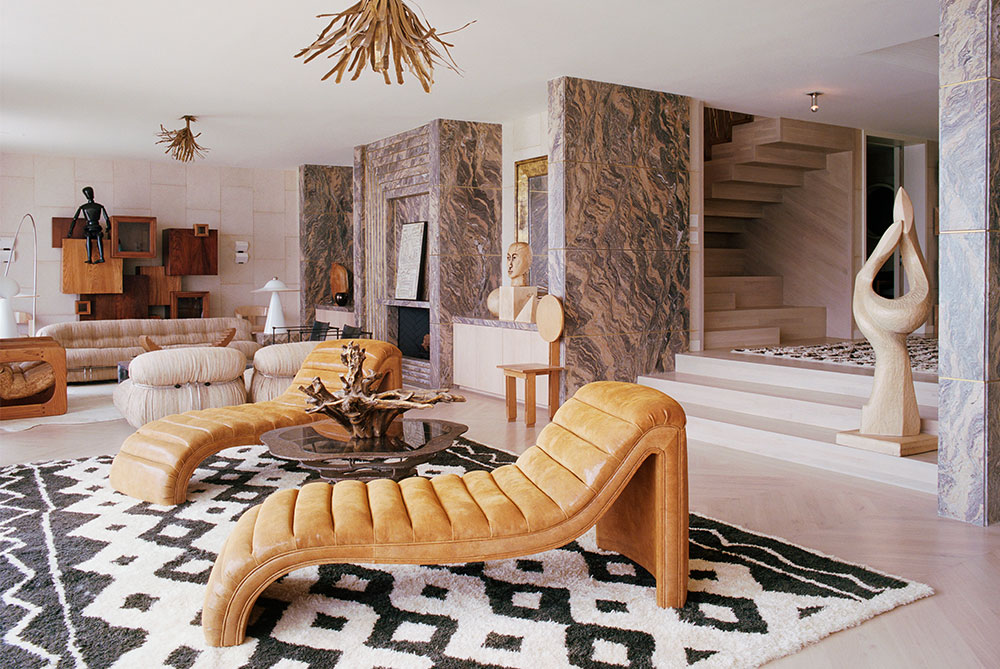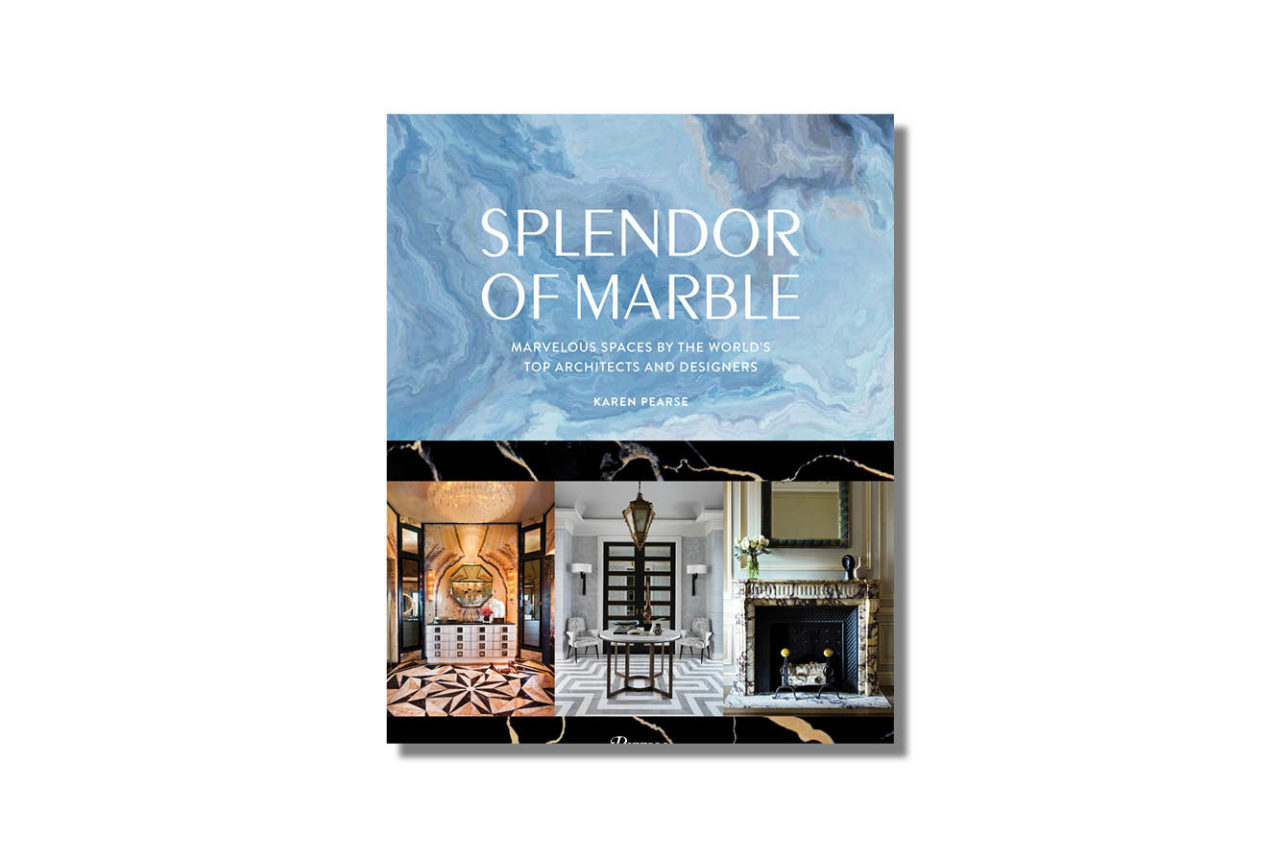A new book celebrates contemporary uses of the time-honored building material, and we highlight two California interior designers giving it some added luster
Words by KAREN PEARSE
The first time I visited a marble quarry, the parallels between art and this metamorphic stone became strikingly clear to me. Just as my grandfather (František Reichentál, a painter) transformed raw canvases, so nature molded minerals and sediments into artful compositions of swirling color and reflective crystals — nature’s brushstrokes.
Photo courtesy of Karen Pearse.
Formed over ages by heat and pressure applied to limestone beneath the earth’s crust, it is almost as if the veins are telling a story. When I stand among the pink cliffs of Rosa Aurora marble in Estremoz, Portugal, and the stark white quarries in Carrara and Pietrasanta, Italy, that were favored by Michelangelo, I feel surrounded by the history of art, architecture, nature and man.
Marble’s uses can be traced back thousands of years. In Tunisia, the mosaic floors of ancient Carthaginian temples depict narratives through the language of marble. The Egyptians revered the stone, employing it only for their most precious vessels in the tombs of the pyramids. The Greeks built legendary temples and monuments that still stand today, including the pillars and tiles of the Parthenon, erected between 447-432 BCE, crafted from Pentelic marble.
A marble mosaic. Photo courtesy of Karen Pearse.
Recently, while working with the quarry and factory that are restoring this iconic temple, I stood among these ruins, temporarily closed to visitors, and marveled at the power of the ancient architecture. Throughout history, marble has been chosen to immortalize the most iconic buildings and monuments: the Pisa Cathedral (1092), the Taj Mahal (1653), the Washington Monument (1888), and the Lincoln Memorial (1922). Indeed, some of the most treasured Beaux-Arts and Art Deco buildings defining our cities — the Chrysler Building and Grand Central Terminal in New York City, and the Palais de Chaillot in Paris — are also adorned with marble.
Throughout history, marble has been chosen to immortalize the most iconic buildings and monuments
The transformation of marble from the raw beauty of the quarry to a finished sculpture, architectural element, or embellished interior is astonishing. I enjoy participating in every step, from finding the perfect material to the final process of fabrication and installation, ensuring that the vision of the architect or designer is fulfilled. Because marble is a metamorphic material, veining and coloration varies immensely, even within the same section of a quarry.
Interior by KELLY WEARSTLER. Honed and leathered finishes on the swirling tan and greige of the Bardiglio marble infuse this Malibu living room with warmth. Photo by Francois Halard.
When I am choosing the perfect block, I study these varied layers and consider the techniques or finishes that will best enhance its beauty. From sandblasting, water-jetting, and honing to book-matching and split-facing, there are innumerable ways to reveal the beauty of a single block of stone. For instance, marble is typically cut with the grain, like wood, but if it is cut against the grain, the effect is completely different. I have seen pieces cut both ways and have used them together in the same project. The result is extraordinary because the pieces match in color and striation but have completely different textures.
It is a very special kind of architect or designer who has an eye for stone. Such artists use everything about it — its texture, color, veining and idiosyncrasies — to create something truly beautiful and unique. Like Michelangelo and the special piece of stone he chose for the David, this process is guided not just by what they see, but also by intuition about what the stone can become.
Selecting the right marble is a marriage of function and design. To make a design come alive the way you envision it, you must introduce the right stone to the right stone person, whether that is an artist, architect, furniture designer, interior designer or craftsman. Because each stone possesses a unique beauty, it is possible to pick the perfect one to match your aesthetic or personality. Unlike paint colors, textiles or wallpaper, each piece of marble is inimitable. Marble can transform a room into something bespoke, something unequivocally your own.
A very special kind of architect or designer with an eye for stone uses everything about it — its texture, color, veining and idiosyncrasies
When I was asked to help with the creation of a mosaic for the Palace of the Lost City in South Africa, I collaborated with an entire team of craftsmen to assemble thousands of colorful fragments of marble. As I watched the men translate a rough sketch depicting animals from Africa into a 60-foot-wide mosaic, I was awestruck by the intricacy and antiquity of their craft. You can start with the most beautiful stone, but if you don’t have the benefit of a stone master’s eye and skilled craftsmen, the results will be nil.
In his own home in Mandeville Canyon, Los Angeles, RON RADZINER uses stone to blur the lines between his home and the landscape outside. The colors of the honed Silver travertine in this shower are reminiscent of the bark on a sycamore tree and meld seamlessly with the outdoors. Interiors by RON RADZINER of MARMOL RADZINER. Photos by Roger Davies.
Until recently, the process of finding the exact perfect marble for a project was very difficult and expensive. Many sources of the most beautiful stone lay undiscovered or in remote, hard-to-access regions. The original machinery for quarrying marble was invented in Italy, where the technique remained a guarded secret. Stone from all over the world had to be sent to Italy to be processed, all of which made marble unobtainable for so many.
In the past few decades, there has been unprecedented advancement in the technology for quarrying and processing stone, as well as an expansion in the international accessibility of that technology. Now it is possible to obtain gorgeous, previously inaccessible and rare types of stone directly from quarries around the world, from China to Turkey to Brazil. The artful possibilities of this marble renaissance are unlimited. One simply needs the imagination, the knowledge, and the tools to bring it to life.
Marble is a gift from nature, and there are few masters of design who know how to make it sing. In the pages of my new book, Splendor Of Marble, I’ve brought together kindred spirits who possess this gift including California’s Kelly Wearstler and Ron Radziner.
Excerpted from Splendor of Marble: Marvelous Spaces by the World’s Top Architects and Designers (Rizzoli New York, $75) by Karen Pearse.
Feature image: Photos courtesy of Karen Pearse.
July 7, 2020
Discover more DESIGN news.









